Alaskan Adventure, August 2005
Day 9: Sunday
We got up and out just in time to take advantage of the free continental breakfast served in the motel office until 10:00 in the morning; we sat there a little while to use their free wireless (not a fabulous range, but they try), and we established pretty conclusively that there is nowhere to have dim sum in Fairbanks.
(How did do this? Basically, we called every Chinese restaurant at 11:30 on a Sunday morning, prime dim sum time, and asked whoever answered the phone if they served dim sum or if they knew where to go to get it. Everyone sounded extremely surprised at the mention of dim sum, but very happy--as though tantalized by something out of a half-dream, half-long-ago-memory. No one seemed ever to have eaten it in the area, although I almost made us stop at a Chinese-language church we passed around noon, hoping that someone there might have the answer--or at least a few bao at the coffeehour.)
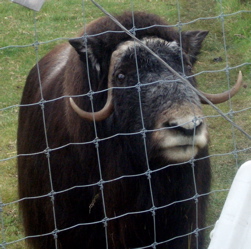 Fairbanks
really is an odd city: it’s extremely spread out, very uncompact, with
lots of low, flat, two-story buildings widely spaced along large divided roads
that aren’t at all clogged with cars. People kept making excuses for
this, like (on a weekend), “Oh, everyone’s fishing in Valdez
now,” and then (on a weekday), “Oh, school started last Thursday
here,” but we don’t really believe that this town/city gets
more crowded. At several points, we just stood in the middle of the streets
downtown and looked around at the dearth of people--what on earth is it like
in winter? That said, Fairbanks is oddly charming--far more compelling than
Talkeetna, I have to say. Plus, it has a movie theatre that operates every
day (unlike everywhere else we stayed except for Anchorage; Valdez and Seward
had theatres, but they only show movies “sometimes,” according
to the people we asked, and we weren’t there on those lucky days).
At right, a friendly female musk ox.
Fairbanks
really is an odd city: it’s extremely spread out, very uncompact, with
lots of low, flat, two-story buildings widely spaced along large divided roads
that aren’t at all clogged with cars. People kept making excuses for
this, like (on a weekend), “Oh, everyone’s fishing in Valdez
now,” and then (on a weekday), “Oh, school started last Thursday
here,” but we don’t really believe that this town/city gets
more crowded. At several points, we just stood in the middle of the streets
downtown and looked around at the dearth of people--what on earth is it like
in winter? That said, Fairbanks is oddly charming--far more compelling than
Talkeetna, I have to say. Plus, it has a movie theatre that operates every
day (unlike everywhere else we stayed except for Anchorage; Valdez and Seward
had theatres, but they only show movies “sometimes,” according
to the people we asked, and we weren’t there on those lucky days).
At right, a friendly female musk ox.
Our first three stops of the day were all on the University of Alaska, Fairbanks campus, on a hill overlooking the city--or just overlooking a sea of mist, either way. During the 1967 flood, the entire town spent several weeks on the campus, since it was the only part of town not under 3-10 feet of water (this story, and many others, we learned from the great old men and women, longtime Fairbanks residents, who work at Pioneer Park and who love to reminisce--more on them later).
First we went to the UAF Museum of the North, which is moved into a beautiful new building, but not fully opened yet. I think we saw most, but not all, of their original collection in the new exhibit hall; there was a great exhibit on Alaska in WWII, from Japanese invasions and prisoner-taking, to US-forced Japanese internment and relocation. We also liked the exhibits on fossils, animals, and native culture.
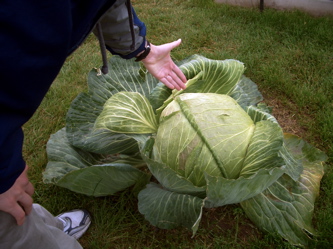 |
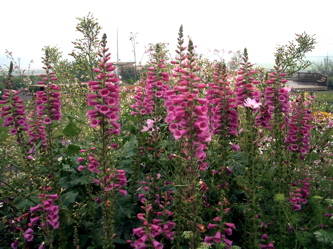 |
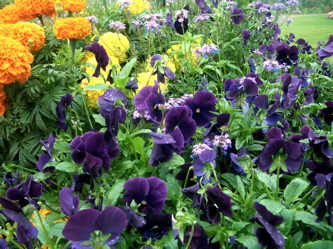 |
Giant cabbages (actually, they're just average for Alaskan summer vegetables), wildflowers, and cultivated flowers in the botanical gardens. |
Our next stop was over to the far side of campus to the huge, impressive, UAF Botanical Gardens, with an enormous array of south-exposed outdoor beds--most in-ground, some raised--full of beautiful flowers, large and varied vegetables and herbs, and very nicely landscaped paths and benches.
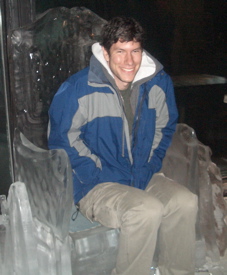 From
there, we went to the UAF Large Animal Research Station (LARS) just in time
to catch one of their twice-daily hour-long tours, with extremely detailed
information about their caribou, reindeer, and musk oxen, both in their native
habitats and here at the research facility, where their breeding, hearing,
and diet are all being studied. Musk oxen are great animals--supposedly there’s
one farm in Maine that has them, and boy, Robert and I are putting that on
the list to go to.
From
there, we went to the UAF Large Animal Research Station (LARS) just in time
to catch one of their twice-daily hour-long tours, with extremely detailed
information about their caribou, reindeer, and musk oxen, both in their native
habitats and here at the research facility, where their breeding, hearing,
and diet are all being studied. Musk oxen are great animals--supposedly there’s
one farm in Maine that has them, and boy, Robert and I are putting that on
the list to go to.
We stopped for a quick lunch at Second Story Cafe over Gulliver’s books (they were having a half-off used book sale this weekend only; we only left with five out-of-print paperbacks I couldn’t live without); I had a very good quesadilla roll and Robert had an odd cream cheese-guacamole-turkey roll, and we both had delicious espresso drinks.
A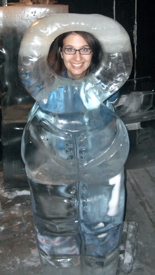 fter
lunch we went downtown to the Ice Museum, which is very small, rather cheesy,
and not really worth its full $10 admission, but which we’re not sorry
we went to anyway. It’s located in an old movie theatre, and there
were only four people other than us there. First you see a movie about the
ice-carving contest held in Fairbanks every March, though Robert insisted
that the “movie” had no moving pictures, that it was only a
slide show. Upon inspection, he was wrong: there actually are three very short
movie segments interspersed among twenty minutes of slides and narration.
Then you can walk into five freezers along the side of the theatre, all of
which contain various ice sculptures and are held at -20 degrees. The most
exciting one has an igloo you can stand inside, and an ice slide you can ride
down (while sitting on a very small padded saucer-type sled). Then, for the
final segment of the museum, you go over to another freezer at the front where
an apprentice ice carver shows you some techniques and carves a flower for
you. The pile of discarded ice flowers was hugely impressive, and we had fun
at the place.
fter
lunch we went downtown to the Ice Museum, which is very small, rather cheesy,
and not really worth its full $10 admission, but which we’re not sorry
we went to anyway. It’s located in an old movie theatre, and there
were only four people other than us there. First you see a movie about the
ice-carving contest held in Fairbanks every March, though Robert insisted
that the “movie” had no moving pictures, that it was only a
slide show. Upon inspection, he was wrong: there actually are three very short
movie segments interspersed among twenty minutes of slides and narration.
Then you can walk into five freezers along the side of the theatre, all of
which contain various ice sculptures and are held at -20 degrees. The most
exciting one has an igloo you can stand inside, and an ice slide you can ride
down (while sitting on a very small padded saucer-type sled). Then, for the
final segment of the museum, you go over to another freezer at the front where
an apprentice ice carver shows you some techniques and carves a flower for
you. The pile of discarded ice flowers was hugely impressive, and we had fun
at the place.
 Next
we headed over to Pioneer Park, formerly known as Alaskaland, a public park
with free admission and many historic buildings and mini-museums inside. The
park was originally conceived of for the Alaska Centennial in 1967, but it
wasn’t even fully set up yet when the massive floods struck Fairbanks
in the summer. According to the chatty, friendly employees--long-time Fairbanks
residents and great sources of or
Next
we headed over to Pioneer Park, formerly known as Alaskaland, a public park
with free admission and many historic buildings and mini-museums inside. The
park was originally conceived of for the Alaska Centennial in 1967, but it
wasn’t even fully set up yet when the massive floods struck Fairbanks
in the summer. According to the chatty, friendly employees--long-time Fairbanks
residents and great sources of or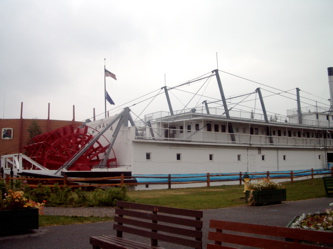 al
history--in the museums, the Riverboat Nenana hadn’t yet arrived at
the park when the floods started and the entire town took refuge at the UA
Fairbanks campus (up on a hill). However, the flood proved fortuitous in that
one regard, at least, because no one had been able to figure out how to get
the massive riverboat into the park: during the floods, they just sailed it
in and dug a small channel for it to sit in when the waters receded. We really
loved this park, though a lot of it is shabby, and it was completely deserted
and seemed underused. Several of the historic log cabins were closed due to
smoke, since when the particulate index on the local smoke hotline gets above
a certain percentage, local businesses have the option of closing so as not
to force employees to go out in bad conditions. Actually, the conditions seemed
far better today than yesterday: there had been some rain in the night, and
it was barely smokey at all, but it seemed like some people didn’t
mind an extra day or afternoon off.
al
history--in the museums, the Riverboat Nenana hadn’t yet arrived at
the park when the floods started and the entire town took refuge at the UA
Fairbanks campus (up on a hill). However, the flood proved fortuitous in that
one regard, at least, because no one had been able to figure out how to get
the massive riverboat into the park: during the floods, they just sailed it
in and dug a small channel for it to sit in when the waters receded. We really
loved this park, though a lot of it is shabby, and it was completely deserted
and seemed underused. Several of the historic log cabins were closed due to
smoke, since when the particulate index on the local smoke hotline gets above
a certain percentage, local businesses have the option of closing so as not
to force employees to go out in bad conditions. Actually, the conditions seemed
far better today than yesterday: there had been some rain in the night, and
it was barely smokey at all, but it seemed like some people didn’t
mind an extra day or afternoon off.
In any case, we went into a handful of the historic log cabins, moved here from their original locations around Fairbanks, all restored to what they would have looked like at the turn of the century. I’d never seen a painted log cabin before, never mind an entire street of pastel-colored ones, but one employee explained that that was the Victorian style: Fairbanks may have been a small town made up of log cabins, but it wasn’t going to look provincial, and so it emulated the colorful sidings of fancier towns and cities. The huge Pioneer Museum was free that afternoon; there are roomfuls of artifacts--mining equipment, telegraph equipment, sleds, clothes, etc.--leading us to realize that Alaska, with its young history, doesn’t so much suffer a scarcity of museum-worthy pieces as it does organized, updated, uncluttered museums in which to display them.
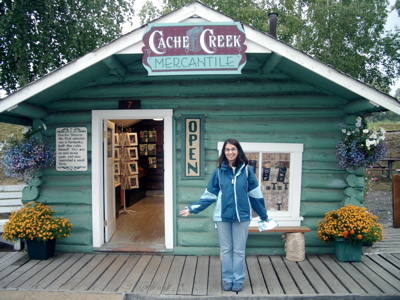 We
then took a tour of the Riverboat just as its employee was closing it up for
the day, for free, and we spent a long time inside the Air Museum (fully open).
The aviation museum was absolutely fabulous, with some of the most talkative
employees. Everyone in Alaska seems to have a story about how they or their
family ended up here, and they’re always fascinating to hear. People
who spend their entire day sitting in a small log cabin or museum, alone,
waiting for tourists to come in, are also usually happy to share their stories,
and we were thrilled to hear them.
We
then took a tour of the Riverboat just as its employee was closing it up for
the day, for free, and we spent a long time inside the Air Museum (fully open).
The aviation museum was absolutely fabulous, with some of the most talkative
employees. Everyone in Alaska seems to have a story about how they or their
family ended up here, and they’re always fascinating to hear. People
who spend their entire day sitting in a small log cabin or museum, alone,
waiting for tourists to come in, are also usually happy to share their stories,
and we were thrilled to hear them.
When we got hungry, we decided to take advantage of the salmon bake right in the park, even though it seemed at first to be overrun by busloads of tourists. We wandered through just to check it out, and we were sold on the free samples of fried halibut and the very friendly grill staff. We walked around the rest of the park, and then we came back around 7:45, which turned out to be the perfect time: most of the tourists had already left, and the last ones were clearing out for the comedy/mining show at 8:15 in a nearby arena, so there were just under twenty people eating in the entire place (half open-air, half enclosed)--compare that to 200 just an hour earlier!
The salmon was great, with a nice brown sugar, lemon, butter, and herb sauce, and the cooks were happy to talk to us and try cooking the salmon lots of different ways on the grill.
Stuffed and happy, we left and tried to make a movie, but the local theatre doesn’t stagger times well: everything seemed to go on at 8:30 or at 10:30, so we skipped a movie in favor of more DVDs in the hotel room and turned in.
Introduction
| Day 1 | Day
2 | Day 3 | Day
4 | Day 5 | Day
6 | Day 7
Day 8 | Day 9 | Day
10 | Day 11 | Day
12 | Day 13 | Day
14